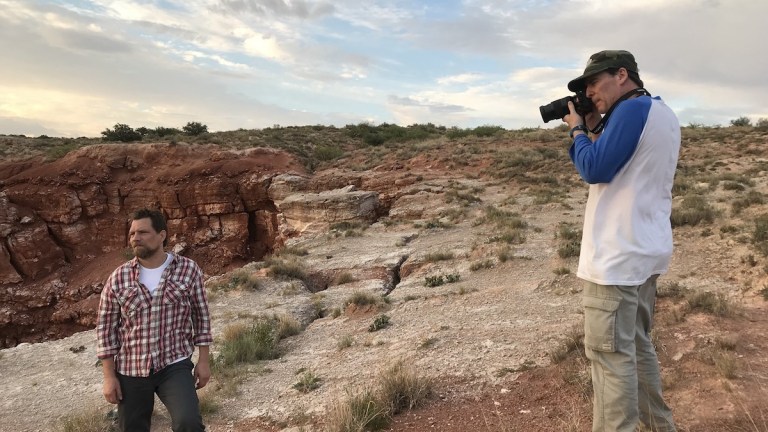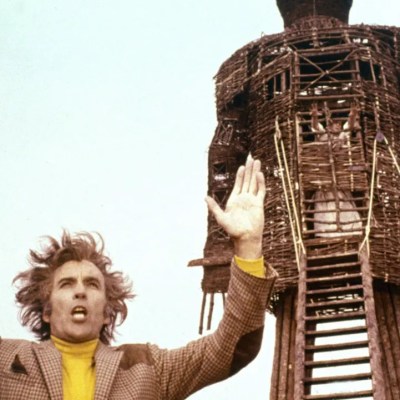The Blair Witch Project to Skyman: How Director Daniel Myrick Came Full Circle With His New Sci-Fi
The Blair Witch Project director tells us how his latest sci-fi mockumentary Skyman is a return to his roots

“Blair Witch, which I consider incredibly fortunate to have been a part of, does come with its own set of baggage,” says Daniel Myrick, one half of the duo who made the found footage phenomenon which scared the hell out of audiences when it was released in cinemas in 1999 and went on to change the face of horror as we know it.
We’re chatting (via Zoom) in the context of Myrick’s new movie, Skyman, a documentary style sci-fi which feels like it could be real, featuring elements of found footage and starring relative unknowns Michael Selle and Nicolette Sweeney, who play Carl Merriweather and his sister Gina. Carl believes he encountered an alien when he was just 10 years old and he’s convinced the being he calls the ‘Skyman’ is going to return for him on his 40th birthday. Along with a documentary film crew, Carl, his sister, and their friend Marcus (Faleolo Alailima) venture to the tricked out shelter in the desert where the encounter took place all those decades ago.
It’s easy to see parallels between Skyman and The Blair Witch Project – both are low budget, with a small cast, shot on location and in documentary style. It was something that Myrick was very aware of when he was developing the script.
“Even though I felt intrinsically drawn to the documentary form for Skyman I was very conscious of people making direct comparisons to Blair,” he says.
“I have three versions of the script. I’ve got one that’s a straight-up scripted narrative, I’ve got another version that is a complete found footage version, where it’s just all Carl’s found footage. And then I’ve got the one I ultimately shot, which is sort of an Errol Morris-style documentary following a character, and drawing my own conclusions, both consciously and subconsciously with the way I put the film together.”
Similarities aside, Skyman is tonally very different. Though the marketing material positions this squarely as hard science fiction the end result is more like a sympathetic character study.
“I wanted to look into the life of a lot of these ‘experiencers’ and people that we would normally write off and maybe dismiss at first glance,” says Myrick. “Carl, I think, represents a subculture of experiencers that, even if you don’t believe what they say is real, they believe it, and it has a huge impact on their lives and their families’ lives. I thought it was a different take on the UFO genre and not necessarily a procedural or whether they’re real or not that we’ve seen a million times. I wanted to take more of a character approach to it.”
Skyman is a portrait of Carl. He’s a bit of an outsider. He’s a smart guy who can fix things but he’s also a little bit odd. He sincerely believes aliens made contact when he was just a child but it’s clear Carl is haunted not just by this experience but by the passing of his and Gina’s father and the stress of trying to connect with and support their mother who is now in a care home.
Myrick knew what he was looking for – or rather what he definitely didn’t want – when he held open auditions for the role of Carl – a part which would make or break the film.
“What I wanted to avoid is the typical or stereotypical wacko that you see oftentimes portrayed as UFO experiencers,” he says. “What I thought was important is that you had to like Carl. Whether you believed in him or not, you had to like him, you had to find him somewhat endearing. He has a little bit of Asperger’s going on so I needed an actor that could play that and all his subtleties and not come off as an over-the-top Rain Man in that.”
Selle nails it, as does Sweeney as the fierce, funny, sister who teases Carl but loves him and sees him clearer than anyone. While Skyman, like Blair Witch, is a journey of three people into the unknown, rather than venturing deeper into a feral, folk horror forest until they are impossibly lost, Carl, Gina and Marcus travel to the wide open spaces of the desert, a place which is, as Myrick rather beautifully puts it, “a vast openness blanketed by stars that are so vivid, you can almost reach out and touch them.”
It’s a very spiritual place for many people, he explains. Myrick seems particularly interested in spirituality, or rather belief, whether that’s in UFOs, ghosts, religion, myth, or anything else – our need to believe there is something more than us out there.
When Myrick was a kid he had a UFO club with his friends where they would research ufology, Roswell, Area 51 and the like. It was around the time when Close Encounters of the Third Kind came out, “so it really tapped into my imagination as a kid – I wanted to ride on a spaceship!” he laughs.
“But as time moves on you start to become more realistic about whether or not there’s little green men living in your backyard,” Myrick says. He’s certainly not ruling out the possibility of intelligent life on other planets but he says what fascinates him more is why people are drawn to it.
“What is it about this subculture and the similarities between the need for explanation in ufology and the need for explanation in religion? There’s a lot of overlap there. We also have to be careful as individuals not to come in with too much preconception of someone we see. It’s easy to polarize and cast generalities on people.”
There’s no more polarizing moment in Skyman than when Carl’s journey takes him to a UFO convention, in search of the truth but also to meet like minded people. These scenes were shot at a real UFO convention and Myrick tells us that in some of these sequences it was just Selle and Myrick and the camera, really getting a sense of intimacy against the backdrop of the busy carnival-like celebrations.
“I wanted to get across that Carl isn’t the festival type of guy. He’s not there to check the parade out or enter the alien costume contest. He’s there to really seek answers,” Myrick explains. While Carl’s there he’s mockingly interviewed for a blog and declares that it’s good to know that he’s not alone, in a sequence where to the viewer he’s never looked more alone.
“Going with unknown actors and taking this approach to it, I felt made the film more intimate and more sincere,” explains Myrick, and he’s right – like with Blair Witch, the subtle and completely convincing performances are what gives the film such pathos.
When The Blair Witch Project arrived, premiering at Sundance, the marketing material tried to convince audiences that Heather, Mike, and Josh really were missing. The actors had to genuinely pretend to be dead. While Skyman definitely has a real life vibe there’s no serious pretence that it’s actually real. In fact it’s debatable whether another Blair Witch could ever really exist in this day and age.
“I mean, I never say never,” says Myrick when we pose this. “Paranormal Activity came out 10 years later and blew everybody away, which was its own phenomenon arguably.” Paranormal Activity certainly started its own found footage boom and deserves a spot in the horror pantheon but whether it’s as culturally significant as Blair Witch is another matter.
Heather Donahue has certainly talked about the down side to her sudden shot to fame at the same time as having to play dead, but for Myrick, who was making his debut with Blair, there were different consequences.
“Yeah, it was quite the whirlwind. I think Ed Sanchez, who co-directed it with me, and I were … we were ill-prepared for how big it became. I mean, if you could pick a film that was smaller by design that ended up being bigger in the consciousness of the culture, you couldn’t find anything bigger than Blair Witch,” he recalls. “I remember joking with Ed. We were in a little crappy office in Orlando, and Blair Witch was really hitting its stride at the box office. And I had the box of these 12 little videotapes that were the raw footage of the movie. I said, ‘This is what this is all about. These stupid little videotapes.’”
12 little videotapes that changed the face of horror and the careers of Myrick and Sanchez almost overnight.
“We had hoped that we would make a movie that would be a calling card project,” he says. “When we got into Sundance, we thought we hit the motherlode and maybe we could get a project or another gig out of it. Our primary concern at the time was just to get the investors’ money back and move onto the next project.”
They ended up getting much more than that.
“Nobody anticipated how big it would become. I know at Sundance, we started getting an indication it was going to be pretty popular. The whirlwind started building there at Sundance in the industry. But it wasn’t until Cannes, I think, for me, that it became much bigger than ourselves, that suddenly it was international.”
Myrick recalls being on a panel at Cannes in the South of France, right on the beachfront, with Spike Lee and John Sayles in the same line up. “We were like, ‘What are we doing here? We have no idea,’” he laughs, saying that he and Sanchez spent a lot of time on planes for the next couple of years. They were the golden children of low budget, high impact horror, and that involved getting sent a lot of bad scripts.
“They wanted us to direct Exorcist 4, which I didn’t want to touch with a 10-foot pole,” Myrick says.
“Artisan, at the time, that bought Blair Witch, wanted us to do a sequel, and offered a lot of money for us to do it. Ed and I felt that it just was too soon, and we wanted some of the hype to die down for a couple of years and revisit some of the other ideas that we had on the Blair Witch mythology and explore some of the backstory. But Artisan had other plans.”
Blair Witch 2: Book of Shadows followed just a year later in 2000 with neither Myrick or Sanchez behind the camera. It was a meta-horror in a completely different style to the original which imagined fans of The Blair Witch Project, the movie, travelling to Burkittsville to investigate the story. Director Joe Berlinger was bought in – Berlinger would later make his name as a documentarian, mostly recently making excellent series The Ted Bundy Tapes, and less successful Bundy dramatization Extremely Evil, Shockingly Wicked and Vile. Book of Shadows had a much bigger budget and in no way replicated the success of the original, either critically or in terms of box office.
“The pressure’s very high to continue the money machine for Hollywood, and they don’t really care too much about your creative whims and what’s inspiring you and what you’re passionate about,” Myrick says.
“It’s one of those things that you get pigeonholed in, and it’s hard to get out of. Especially when they’re throwing money at you and saying, ‘Do this or that.’ It’s tough to say no when you’ve been broke most of your adult life, having to make these choices.”
Instead Myrick moved to Hollywood to forge his own path. Teamed with a couple of studio producers he struck a deal with Warner Home Video where he made six features back to back – movies he describes as Twilight Zone-esque.
“On paper, it’s like a great setup, where we had six films funded, and we write the stories ourselves, but they all had to fit within this kind of marketing box, that Warner DVD wanted us to be within. Naively, I thought ‘Oh, I can make that work, and I can get my vision on the screen’ but it was a rude awakening. You realize that you don’t even get to choose your own title of the film or what the poster looks like or how it gets marketed. They were successful efforts. There’s nothing against that period of time, but I also felt it was very restricting for me. I’m just not good when I don’t have control over my own destiny.”
The Blair Witch legacy wasn’t over then, and perhaps it’s not over yet. 2016 saw the surprise announcement that a mysterious Lionsgate horror called ‘The Woods’ was actually a direct sequel to The Blair Witch Project, entitled simply Blair Witch. Myrick was involved as executive producer and says it’s his favorite interpretation so far, because it doesn’t mess with the mythology of the original. Though the movie wasn’t especially successful Myrick isn’t ruling out a wider Blair Witch expanded universe – and even one he might want to be involved in more directly.
“I would love to do a black-and-white noir Rustin Parr period piece, which I think would be super-creepy,” he says. “It’s a bit of a risk, right? Lionsgate, who owns the rights now, would have to go, ‘All right, Dan, go do your black-and-white noir.’ But it would be cool. I don’t know a Blair Witch fan that I haven’t mentioned a black-and-white Rustin Parr story to, that doesn’t go, ‘Oh, man, I’d go check that out.’”
Oh man. We would go check that out.
More than 20 years on and Myrick has of course matured as a director but there are lessons he says he has learned back from his days on Blair Witch. Namely that a film taking on a life of its own is something to be celebrated and not fought.
“That is a big thing that I learned, especially through Blair Witch, which was an experiment in its own right and tossed out a lot of the rules we were taught in film school about how to direct and how to position the camera and lighting. All that got thrown out, so it really forced you to, in a way, un-direct – to allow the process to happen and recognize when it’s going right and when it’s going wrong, but not be your own worst enemy, trying to steer it too much.”
Perhaps this is part of the key to the special ‘realness’ that comes across in both The Blair Witch Project and Skyman, as different as the two might be. Whether you see similarities in the content and style, what definitely links the two is that they are personal and they are Myrick’s own, through and through. They are passion projects, and they are what he wants to make.
“I’ve just seen too many people in Hollywood, making a ton of money, absolutely miserable making movies, and I never wanted to be that person,” he says. “I would rather live more humbly and make smaller films and have a blast doing it, like we did with Skyman. I can die a happy man if that’s all I get to do.”

